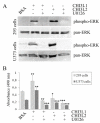Two closely related human members of chitinase-like family, CHI3L1 and CHI3L2, activate ERK1/2 in 293 and U373 cells but have the different influence on cell proliferation
- PMID: 22211103
- PMCID: PMC3226031
- DOI: 10.7150/ijbs.8.39
Two closely related human members of chitinase-like family, CHI3L1 and CHI3L2, activate ERK1/2 in 293 and U373 cells but have the different influence on cell proliferation
Abstract
The activation of extracellular signal-regulated kinases (ERK1/2) has been associated with specific outcomes. Sustained activation of ERK1/2 by nerve growth factor (NGF) is associated with translocation of ERKs to the nucleus of PC12 cells and precedes their differentiation into sympathetic-like neurons whereas transient activation by epidermal growth factor (EGF) leads to cell proliferation. It was demonstrated that different growth factors initiating the same cellular signaling pathways may lead to the different cell destiny, either to proliferation or to the inhibition of mitogenesis and apoptosis. Thus, further investigation on kinetic differences in activation of certain signal cascades in different cell types by biologically different agents are necessary for understanding the mechanisms as to how cells make a choice between proliferation and differentiation.It was reported that chitinase 3-like 1 (CHI3L1) protein promotes the growth of human synovial cells as well as skin and fetal lung fibroblasts similarly to insulin-like growth factor 1 (IGF1). Both are involved in mediating the mitogenic response through the signal-regulated kinases ERK1/2. In addition, CHI3L1 which is highly expressed in different tumors including glioblastomas possesses oncogenic properties. As we found earlier, chitinase 3-like 2 (CHI3L2) most closely related to human CHI3L1 also showed increased expression in glial tumors at both the RNA and protein levels and stimulated the activation of the MAPK pathway through phosphorylation of ERK1/2 in 293 and U87 MG cells. The work described here demonstrates the influence of CHI3L2 and CHI3L1 on the duration of MAPK cellular signaling and phosphorylated ERK1/2 translocation to the nucleus. In contrast to the activation of ERK1/2 phosphorylation by CHI3L1 that leads to a proliferative signal (similar to the EGF effect in PC12 cells), activation of ERK1/2 phosphorylation by CHI3L2 (similar to NGF) inhibits cell mitogenesis and proliferation.
Keywords: ERK1/2; HC gp-39; MAP kinase).; YKL-39) protein; YKL-40) protein; chitinase 3-like 1 (CHI3L1; chitinase 3-like 2 (CHI3L2.
Conflict of interest statement
Conflict of Interests: The authors have declared that no conflict of interest exists.
Figures






Similar articles
-
Chitinase 3-like protein 2 (CHI3L2, YKL-39) activates phosphorylation of extracellular signal-regulated kinases ERK1/ERK2 in human embryonic kidney (HEK293) and human glioblastoma (U87 MG) cells.Tsitol Genet. 2010 Jan-Feb;44(1):3-9. Tsitol Genet. 2010. PMID: 20201406
-
Chitinase 3-like 1 promotes macrophage recruitment and angiogenesis in colorectal cancer.Oncogene. 2012 Jun 28;31(26):3111-23. doi: 10.1038/onc.2011.498. Epub 2011 Nov 7. Oncogene. 2012. PMID: 22056877 Free PMC article.
-
Involvement of the MAPK and PI3K pathways in chitinase 3-like 1-regulated hyperoxia-induced airway epithelial cell death.Biochem Biophys Res Commun. 2012 May 18;421(4):790-6. doi: 10.1016/j.bbrc.2012.04.085. Epub 2012 Apr 23. Biochem Biophys Res Commun. 2012. PMID: 22554524
-
Potential role of chitinase 3-like-1 in inflammation-associated carcinogenic changes of epithelial cells.World J Gastroenterol. 2009 Nov 14;15(42):5249-59. doi: 10.3748/wjg.15.5249. World J Gastroenterol. 2009. PMID: 19908331 Free PMC article. Review.
-
Role of chitinase-like proteins in cancer.Biol Chem. 2016 Mar;397(3):231-47. doi: 10.1515/hsz-2015-0269. Biol Chem. 2016. PMID: 26733160 Review.
Cited by
-
Targeting Chitinase 1 and Chitinase 3-Like 1 as Novel Therapeutic Strategy of Pulmonary Fibrosis.Front Pharmacol. 2022 Mar 17;13:826471. doi: 10.3389/fphar.2022.826471. eCollection 2022. Front Pharmacol. 2022. PMID: 35370755 Free PMC article. Review.
-
Dis3L2 regulates cell proliferation and tissue growth through a conserved mechanism.PLoS Genet. 2020 Dec 28;16(12):e1009297. doi: 10.1371/journal.pgen.1009297. eCollection 2020 Dec. PLoS Genet. 2020. PMID: 33370287 Free PMC article.
-
Inflammatory Effects and Regulatory Mechanisms of Chitinase-3-like-1 in Multiple Human Body Systems: A Comprehensive Review.Int J Mol Sci. 2024 Dec 15;25(24):13437. doi: 10.3390/ijms252413437. Int J Mol Sci. 2024. PMID: 39769202 Free PMC article. Review.
-
Abnormally high expression of CHI3L1 in peripheral blood mononuclear cells and serum and their potential diagnosis and prediction from lymphoma patients.Front Immunol. 2025 Apr 7;16:1557802. doi: 10.3389/fimmu.2025.1557802. eCollection 2025. Front Immunol. 2025. PMID: 40260255 Free PMC article.
-
Imaginal disk growth factors are Drosophila chitinase-like proteins with roles in morphogenesis and CO2 response.Genetics. 2023 Feb 9;223(2):iyac185. doi: 10.1093/genetics/iyac185. Genetics. 2023. PMID: 36576887 Free PMC article.
References
-
- Raman M, Chen W, Cobb MH. Differential regulation and properties of MAPKs. Oncogene. 2007;26:3100–12. - PubMed
-
- Murphy LO, Smith S, Chen RH. et al. Molecular interpretation of ERK signal duration by immediate early gene products. Nat Cell Biol. 2002;4:556–64. - PubMed
-
- Henrissat B, Davies G. Structural and sequence-based classification of glycoside hydrolases. Curr Opin Struct Biol. 1997;7:637–44. - PubMed
Publication types
MeSH terms
Substances
LinkOut - more resources
Full Text Sources
Other Literature Sources
Molecular Biology Databases
Research Materials
Miscellaneous

